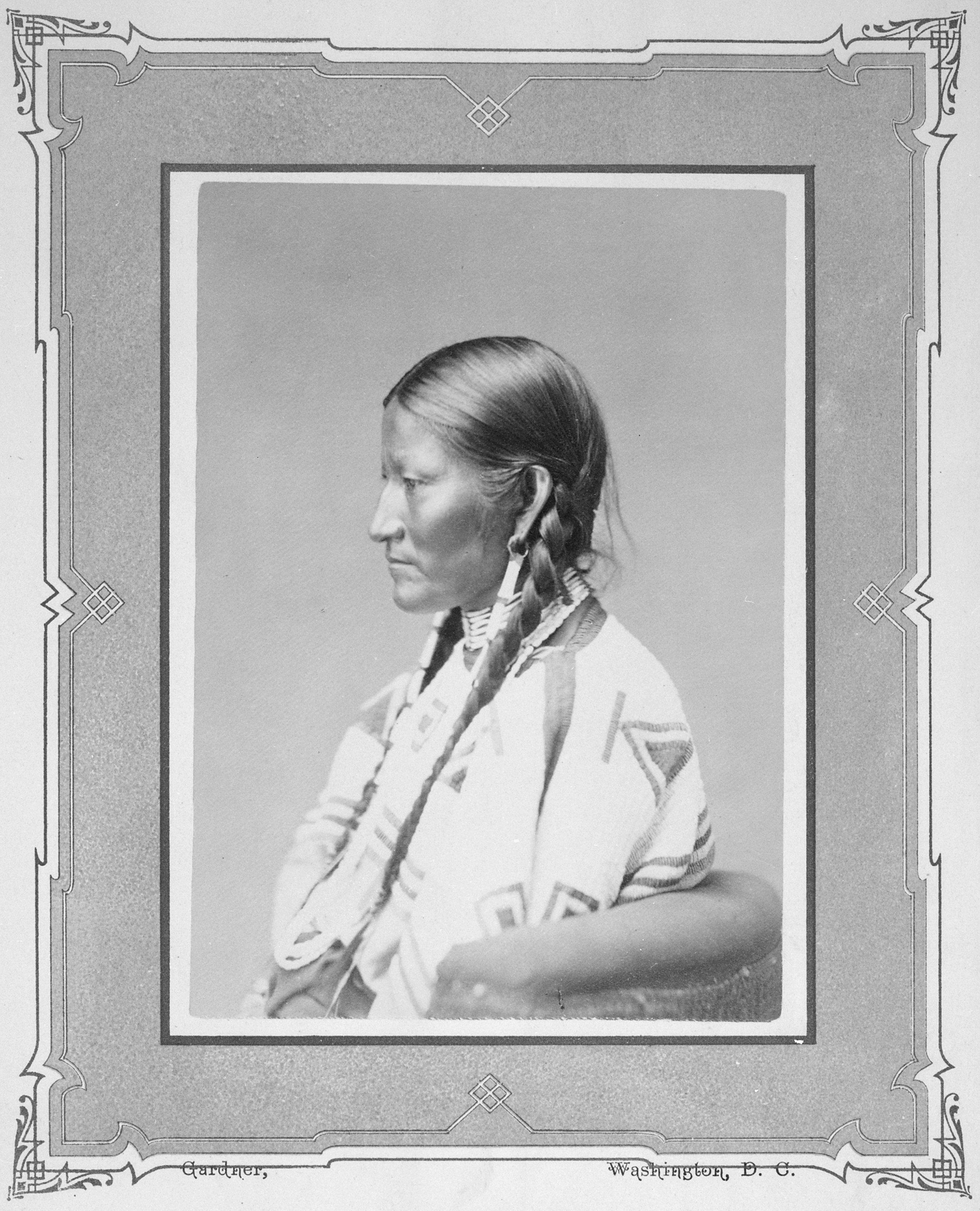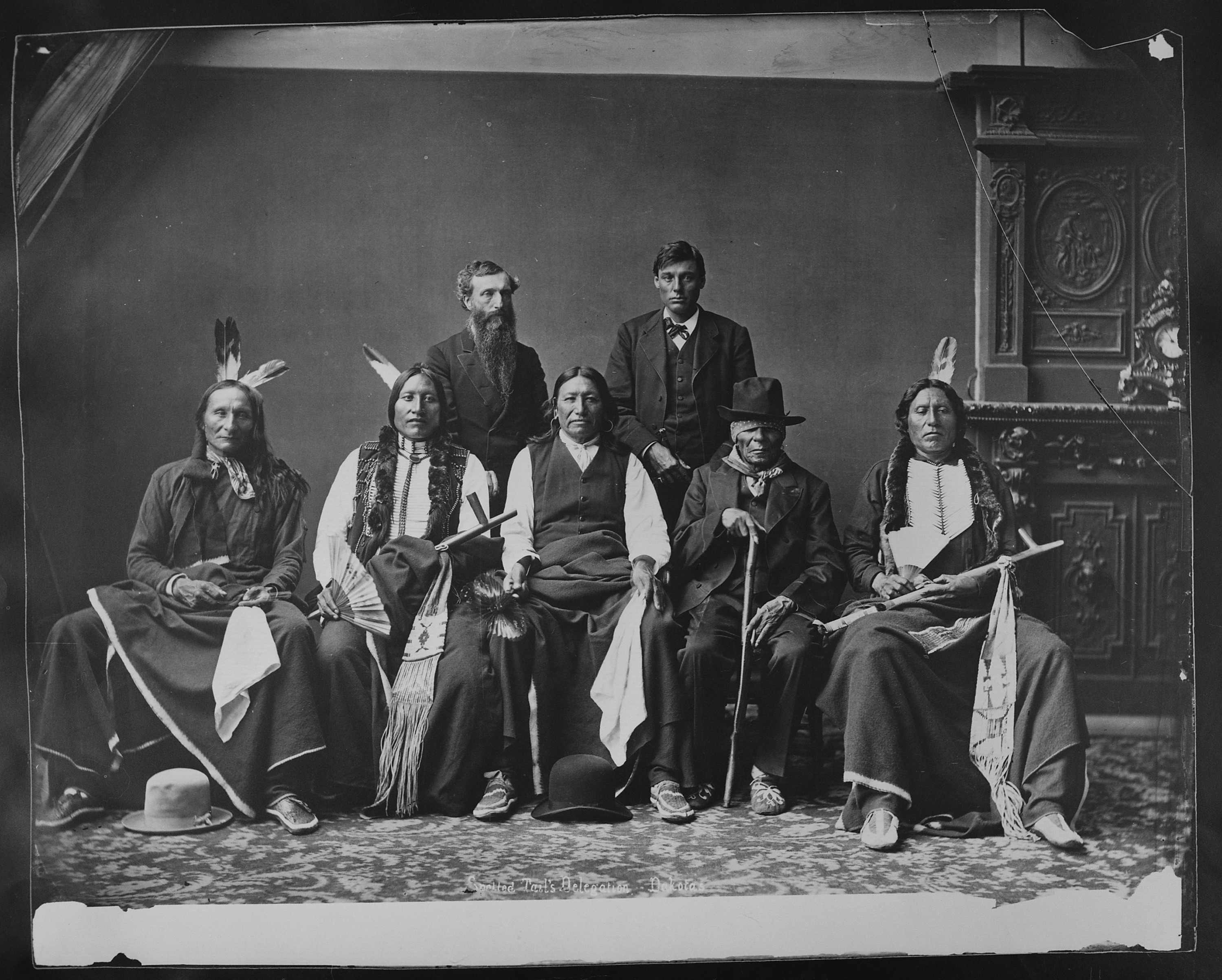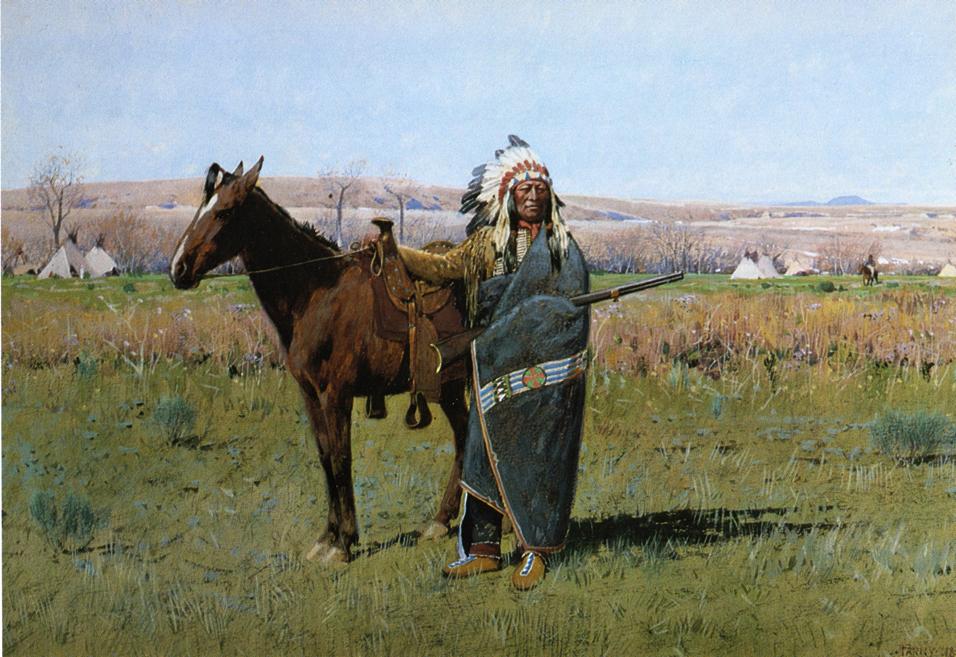Spotted Tail Agency on:
[Wikipedia]
[Google]
[Amazon]
Spotted Tail (Siŋté Glešká pronounced ''gleh-shka''; birth name T'at'aŋka Napsíca "Jumping Buffalo"Ingham (2013) uses 'c' to represent 'č'. ); born c. 1823 – died August 5, 1881) was a Brulé Lakota tribal chief. Although a great warrior in his youth, and having taken part in the Grattan massacre, he declined to participate in
 Spotted Tail married and had children. Eugene Fitch Ware, a
Spotted Tail married and had children. Eugene Fitch Ware, a
 In 1874,
In 1874, 
 Spotted Tail is buried in Rosebud, South Dakota. A tribal university (
Spotted Tail is buried in Rosebud, South Dakota. A tribal university (History of Sinte Gleska
Sinte Gleska University
Red Cloud's War
Red Cloud's War (also referred to as the Bozeman War or the Powder River War) was an armed conflict between an alliance of the Lakota, Northern Cheyenne, and Northern Arapaho peoples against the United States that took place in the Wyoming and M ...
. He had become convinced of the futility of opposing the white incursions into his homeland; he became a statesman, speaking for peace and defending the rights of his tribe.
He made several trips to Washington, D.C.
)
, image_skyline =
, image_caption = Clockwise from top left: the Washington Monument and Lincoln Memorial on the National Mall, United States Capitol, Logan Circle, Jefferson Memorial, White House, Adams Morgan, ...
in the 1870s to represent his people, and was noted for his interest in bringing education to the Sioux
The Sioux or Oceti Sakowin (; Dakota language, Dakota: Help:IPA, /otʃʰeːtʰi ʃakoːwĩ/) are groups of Native Americans in the United States, Native American tribes and First Nations in Canada, First Nations peoples in North America. The ...
. He was shot and killed by Crow Dog, a Brulé Lakota subchief, in 1881 for reasons which have been disputed.
Early years
Spotted Tail was born about 1823 in the White River country west of the Missouri River in present-day South Dakota. His father, Cunka or Tangle Hair, was from the Saône band, and his mother, Walks-with-the-Pipe, was a Brulé. He was given the birth name of Jumping Buffalo. During the previous 40 years, the Lakota or Teton Sioux had moved from present-dayMinnesota
Minnesota () is a state in the upper midwestern region of the United States. It is the 12th largest U.S. state in area and the List of U.S. states and territories by population, 22nd most populous, with over 5.75 million residents. Minne ...
and eastern South Dakota
South Dakota (; Sioux language, Sioux: , ) is a U.S. state in the West North Central states, North Central region of the United States. It is also part of the Great Plains. South Dakota is named after the Lakota people, Lakota and Dakota peo ...
to areas west of the Missouri. They had differentiated into several sub-tribes or bands, including the Saône, Brulé and Oglala
The Oglala (pronounced , meaning "to scatter one's own" in Lakota language) are one of the seven subtribes of the Lakota people who, along with the Dakota, make up the Očhéthi Šakówiŋ (Seven Council Fires). A majority of the Oglala live ...
. During this time the people adopted the use of horse
The horse (''Equus ferus caballus'') is a domesticated, one-toed, hoofed mammal. It belongs to the taxonomic family Equidae and is one of two extant subspecies of ''Equus ferus''. The horse has evolved over the past 45 to 55 million ...
s and expanded their range in hunting the buffalo across their wide grazing patterns.
The young man took his warrior name, Spotted Tail, after receiving a gift of a raccoon
The raccoon ( or , ''Procyon lotor''), sometimes called the common raccoon to distinguish it from other species, is a mammal native to North America. It is the largest of the procyonid family, having a body length of , and a body weight o ...
tail from a white trapper; he sometimes wore a raccoon tail in his war bonnet
A modern-day Dog_Soldiers.html" ;"title="Cheyenne Dog Soldiers">dog soldier wearing a feathered headdress during a pow wow at the Indian Summer festival in Henry Maier Festival Park, Milwaukee, Wisconsin. 2008.
War bonnets (also called warbonne ...
. He took part in the Grattan Massacre. Two of his sisters, Iron Between Horns and Kills Enemy, were married to the elder Crazy Horse, in what was traditional Sioux practice for elite men. Spotted Tail may have been the maternal uncle of the famous warrior Crazy Horse
Crazy Horse ( lkt, Tȟašúŋke Witkó, italic=no, , ; 1840 – September 5, 1877) was a Lakota war leader of the Oglala band in the 19th century. He took up arms against the United States federal government to fight against encroachment by ...
, which meant he was a relative of the notable Touch the Clouds as well.
General Anson Mills, who knew Spotted Tail well, called him "a fine-looking man, with engaging manners, perfectly loyal to the government, a lover of peace, knowing no good could come to his people from war," a man who had both a high respect for and confidence in U.S. Army officers as well as a good sense of humor.
Marriage and family
 Spotted Tail married and had children. Eugene Fitch Ware, a
Spotted Tail married and had children. Eugene Fitch Ware, a Fort Laramie
Fort Laramie (founded as Fort William and known for a while as Fort John) was a significant 19th-century trading-post, diplomatic site, and military installation located at the confluence of the Laramie and the North Platte rivers. They joined ...
army officer, wrote that Spotted Tail's daughter, ''Ah-ho-appa'' (Fallen Leaf), "... was one of those individuals found in all lands, at all places, and among all people; she was misplaced." He suggested that she adopted some European-American practices, and that she was thought to be secretly in love with one of the officers at the fort. When she was dying in 1866, Fallen Leaf made her father promise that she would be buried on a hillside overlooking Fort Laramie. The entire garrison at the post helped Spotted Tail to honor her request by arranging for a ceremonial funeral, including a Christian service and Sioux ceremony. Many years later, Spotted Tail had her remains transported to the Rosebud Indian Agency in South Dakota and re-interred.
The Treaty of Fort Laramie
Spotted Tail agreed to the treaty, which in 1868 established the Great Sioux Reservation in West River, west of the Missouri River. In 1871, the senior Spotted Tail visitedWashington, D.C.
)
, image_skyline =
, image_caption = Clockwise from top left: the Washington Monument and Lincoln Memorial on the National Mall, United States Capitol, Logan Circle, Jefferson Memorial, White House, Adams Morgan, ...
to meet the Commissioner of Indian Affairs Ely S. Parker
Ely Samuel Parker (1828 – August 31, 1895), born ''Hasanoanda'' ( Tonawanda Seneca), later known as ''Donehogawa'', was a U.S. Army officer, engineer, and tribal diplomat. He was bilingual, speaking both Seneca and English, and became fri ...
and President Ulysses S. Grant. While there, he met with Red Cloud
Red Cloud ( lkt, Maȟpíya Lúta, italic=no) (born 1822 – December 10, 1909) was a leader of the Oglala Lakota from 1868 to 1909. He was one of the most capable Native American opponents whom the United States Army faced in the western ...
, a chief of the Oglala Lakota, and they agreed to work together on preserving Sioux rights and land.
In 1881, following the Black Hills War
The Great Sioux War of 1876, also known as the Black Hills War, was a series of battles and negotiations that occurred in 1876 and 1877 in an alliance of Lakota Sioux and Northern Cheyenne against the United States. The cause of the war was the ...
, Spotted Tail was killed by Crow Dog for reasons that have been disputed. Luther Standing Bear
Luther Standing Bear (Óta Kté or "Plenty Kill," also known as Matȟó Nážiŋ or "Standing Bear", 1868 - 1939) was a Sicangu and Oglala Lakota author, educator, philosopher, and actor. He worked to preserve Lakota culture and sovereignty, and ...
claimed Spotted Tail was killed by Crow Dog for having sold land not belonging to him and for taking the wife of a crippled man. Although these actions are said to have angered many Sioux leaders, Spotted Tail refused to give the woman back, claiming the United States government stood behind him. Several men decided to kill Spotted Tail but, before they could act, he was killed by Crow Dog on August 5, 1881. According to historian Dee Brown: "White officials...dismissed the killing as the culmination of a quarrel over a woman, but Spotted Tail's friends said that it was the result of a plot to break the power of the chiefs."*
Prelude to the Great Sioux War of 1876-77
 In 1874,
In 1874, George Armstrong Custer
George Armstrong Custer (December 5, 1839 – June 25, 1876) was a United States Army officer and cavalry commander in the American Civil War and the American Indian Wars.
Custer graduated from West Point in 1861 at the bottom of his clas ...
led a reconnaissance mission into Sioux territory that reported gold in the Black Hills
The Black Hills ( lkt, Ȟe Sápa; chy, Moʼȯhta-voʼhonáaeva; hid, awaxaawi shiibisha) is an isolated mountain range rising from the Great Plains of North America in western South Dakota and extending into Wyoming, United States. Black Elk P ...
, an area held sacred by the local Indians. Formerly, the Army tried to keep miners out but did not succeed; the threat of violence grew. In May 1875, delegations headed by Spotted Tail, Red Cloud, and Lone Horn
Lone Horn ( Lakota: Hewáŋžiča, or in historical spelling "Heh-won-ge-chat" or "Ha-wón-je-tah"), also called One Horn (1790 –1877), born in present-day South Dakota, was chief of the Wakpokinyan (Flies Along the Stream) band of the Min ...
traveled to Washington, D.C. in a last-ditch attempt to persuade President Grant to honor existing treaties and stem the flow of miners into their territories. The Indians met with Grant, Secretary of the Interior Delano, and Commissioner of Indian Affairs Smith, who informed them that Congress wanted to resolve the matter by giving the tribes $25,000 for their land and resettling them into Indian Territory
The Indian Territory and the Indian Territories are terms that generally described an evolving land area set aside by the United States Government for the relocation of Native Americans who held aboriginal title to their land as a sovereign ...
. The Indians rejected such a treaty, with Spotted Tail's reply to the proposition being as follows:
My father, I have considered all the Great Father told me, and have come here to give you an answer.... When I was here before, the President gave me my country, and I put my stake down in a good place, and there I want to stay.... I respect the Treaty (doubtless referring to the 1868 Treaty of Fort Laramie) but the white men who come in our country do not. You speak of another country, but it is not my country; it does not concern me, and I want nothing to do with it. I was not born there.... If it is such a good country, you ought to send the white men now in our country there and let us alone....

Death in 1881
On August 5, 1881, after a long simmering feud, Crow Dog shot and killed Chief Spotted Tail on the Rosebud Indian Reservation. Crow Dog was arrested and tried in a territorial court in Deadwood, Dakota Territory, and found guilty of murder and sentenced to hang. In the case of ''Ex parte Crow Dog
''Ex parte Crow Dog'', 109 U.S. 556 (1883), is a landmark decision of the Supreme Court of the United States that followed the death of one member of a Native American tribe at the hands of another on reservation land. Crow Dog was a member of th ...
'', the United States Supreme Court
The Supreme Court of the United States (SCOTUS) is the highest court in the federal judiciary of the United States. It has ultimate appellate jurisdiction over all U.S. federal court cases, and over state court cases that involve a point ...
overturned the verdict because the Deadwood Court had no jurisdiction in a case of one Indian killing another on reservation lands. Crow Dog was released and returned to the Rosebud.
Sinte Gleska University
Sinte Gleska University (SGU) is a public tribal land-grant university in Mission, South Dakota, on the Rosebud Indian Reservation. This is a Brulé Lakota Indian Reservation home to the Sicangu (Burnt Thigh). SGU has an enrollment of 828 ful ...
) on the Rosebud Indian Reservation
The Rosebud Indian Reservation is an Indian reservation in South Dakota, United States. It is the home of the federally recognized Rosebud Sioux Tribe, who are Sicangu, a band of Lakota people. The Lakota name ''Sicangu Oyate'' translates as ...
in South Dakota
South Dakota (; Sioux language, Sioux: , ) is a U.S. state in the West North Central states, North Central region of the United States. It is also part of the Great Plains. South Dakota is named after the Lakota people, Lakota and Dakota peo ...
was named for him in 1971.Sinte Gleska University
Impact on Indian Legal Jurisprudence and Tribal Sovereignty
Spotted Tail's death influenced critical Indian law principles, long after his death. The case of ''Ex parte Crow Dog'' established that Indian tribes retain their sovereignty. The case also motivated the immediate creation, starting in 1885 of a series of federal statutes laying out the division of power between federal courts and Indian tribal courts to try Indian and non-Indian persons, in different circumstances for different crimes on Indian reservations. However ''Ex parte Crow Dog'' also established the plenary powers doctrine, giving Congress the power to pass any law they choose (including laws altering treaties that had been previously entered into), even over the opposition of the tribe or tribes affected.See also
* Paha Sapa (The Black Hills photography.) * ''Ex parte Crow Dog
''Ex parte Crow Dog'', 109 U.S. 556 (1883), is a landmark decision of the Supreme Court of the United States that followed the death of one member of a Native American tribe at the hands of another on reservation land. Crow Dog was a member of th ...
''
Notes
References
Sources
* *External links
* {{DEFAULTSORT:Spotted Tail 1820s births 1881 deaths Brulé people Murdered Native American people People of the Great Sioux War of 1876 Lakota leaders Native American leaders American frontier People murdered in South Dakota Date of birth unknown Place of death missing People from Rosebud Indian Reservation, South Dakota 1881 murders in the United States Deaths by firearm in South Dakota